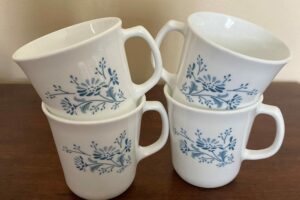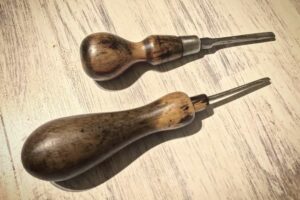
Collecting rare antique marbles is a fascinating hobby, allowing you to dive into the rich history and appreciate the artistry behind these small treasures. Being able to accurately identify and put a value on antique marbles is a skill that requires both knowledge and experience. In this guide, you will learn essential tips and factors to help you recognize and assess the worth of various rare antique marbles.
The age, craftsmanship, and materials used in antique marbles significantly contribute to their rarity and value. As you delve deeper into the world of marbles, you will discover several types and styles, such as hand-blown glass, clay, or even wooden marbles, each with their unique characteristics. Understanding the differences between machine-made and handmade marbles, as well as identifying the various patterns and designs, will enable you to better estimate the value of the pieces in your collection.
It’s important to note that the market for antique marbles is constantly changing, with values fluctuating based on demand and collector preferences. Keeping yourself updated and well-informed in this field is key to staying ahead and maintaining an impressive collection. As you continue to explore the world of rare antique marbles, let this guide be your reliable resource to assist you in your search for these captivating and valuable objects.
Table of Contents
History of Antique Marbles
Origins and Early History
The origin of antique marbles is not entirely clear, as they have been found in various ancient civilizations, such as Ancient Egypt and Nepal, dating back around 4500 years. Early marbles were made from non-glass materials like wood, clay, and stone. They have been discovered in Native American burial grounds, Egyptian pyramids, and the ruins of Pompeii. Marbles were named by the ancient Romans and Grecians, who played with marbles made of marble.
Invention of Glass Marbles
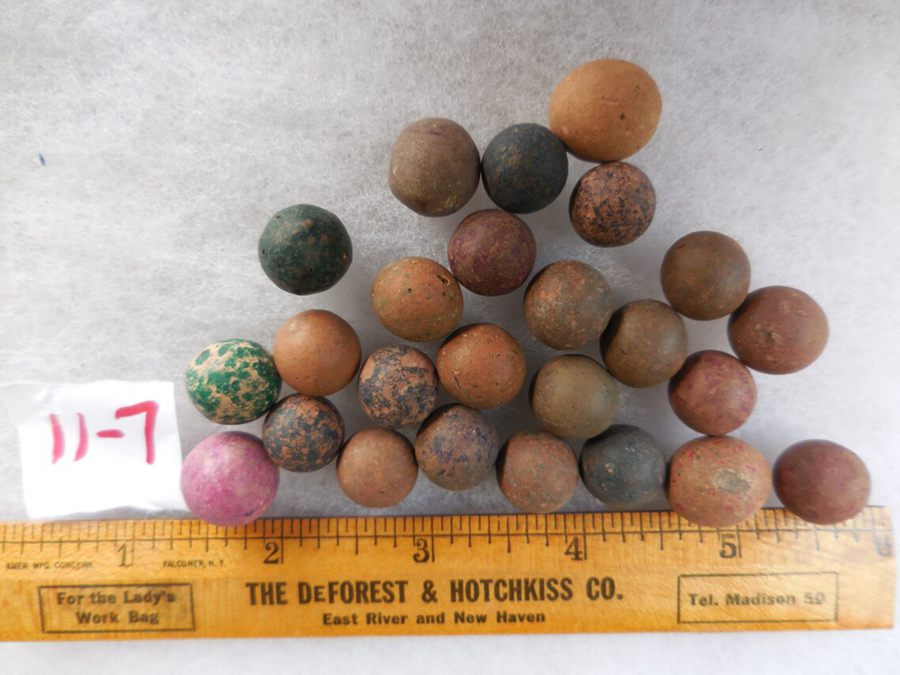
In the 1800s, marbles began to be manufactured on a larger scale. Initially, a European factory produced inexpensive clay marbles using various ceramic techniques. However, the game-changer came when marble manufacturers in the Thuringia region of Germany started producing marbles from glass. This innovation was soon embraced by others, and glass marbles became more widespread.
Evolution in the United States
Around the same time, the first ceramic marbles were made in the United States by SC Dyke. As the demand for marbles grew, manufacturers began mass-producing and shipping them to locations across the country. This led to the creation of a thriving industry around marbles in the US. However, original and antique marbles remained limited in number, making them valuable collector’s items – some fetching prices as high as $7,000-$9,000.
How Antique Marbles Are Made
Antique marbles are small, spherical objects made primarily from glass, clay, or stone, treasured by collectors for their age and unique qualities. In this section, you will learn how these marbles were made, focusing on the glassblowing techniques and materials used.
Firstly, it is essential to know that antique marbles were typically handmade. Skilled artisans used wooden blocks, molds, and a glassblowing technique to create these small works of art. During the glassblowing process, the craftsman would gather molten glass on the end of a blowpipe and shape it into a round form.
To create the distinct patterns and colors present in antique marbles, glassmakers would add colored glass canes or rods to the molten glass. These additions would be carefully melted and blended to achieve the desired design.
Here are some main types of antique glass marbles created by artisans:
- Swirl: Marbles with twisted bands or spirals of color
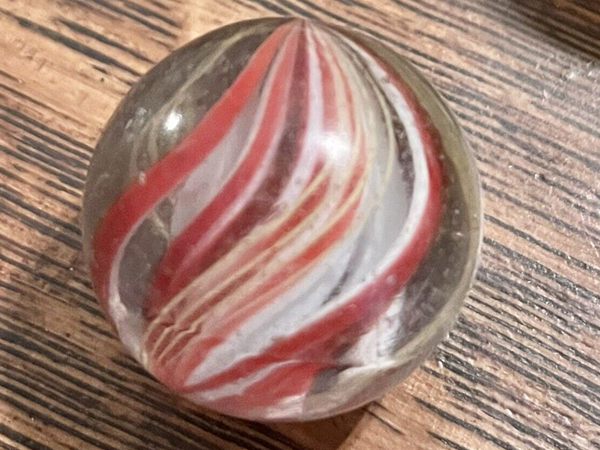
- Mica: Marbles with glittery flakes suspended in translucent glass
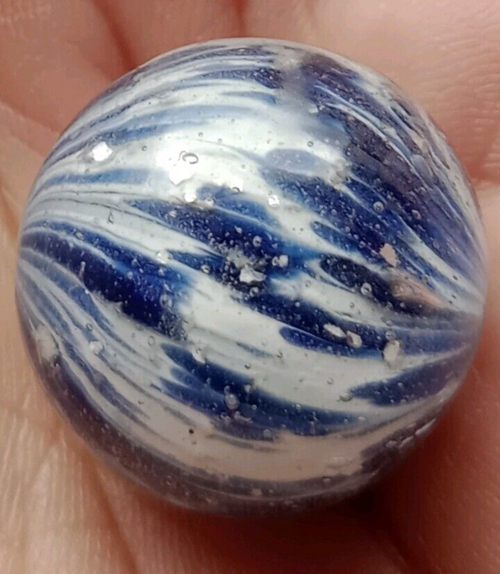
- Lutz: Marbles with sparkling goldstone, usually in bands or ribbons
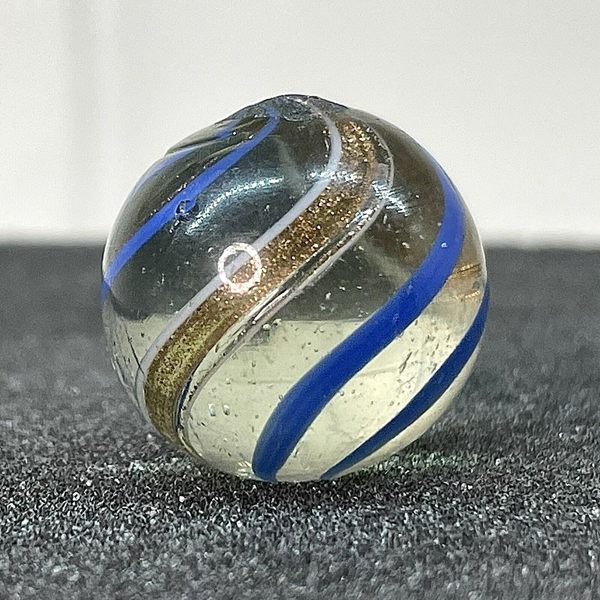
- Onion Skin: Marbles with a thin layer of colors on the surface, resembling an onion skin

Aside from glass, some marbles were made from non-glass materials, such as clay, stone, or even wood. For example, clay marbles were often created by shaping wet clay into spheres and firing them in kilns to harden.
Handmade marbles typically exhibit pontil marks, which are small rough spots where the marble was detached from the glassblowing rod. These marks can be used as an indicator of a marble’s vintage status and authenticity.
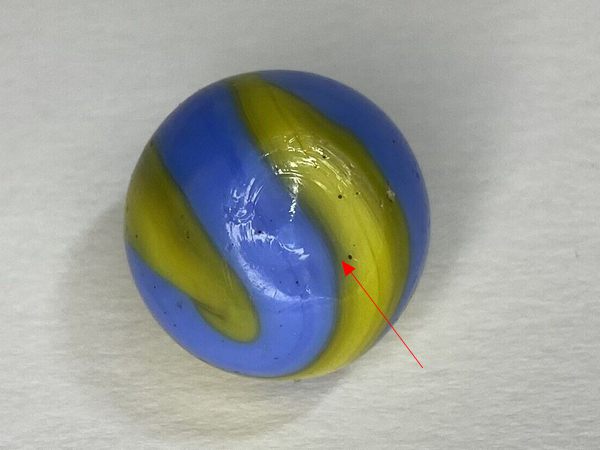
As you delve into the fascinating world of antique marbles, remember that identifying genuine examples and determining their value largely depends on their condition, uniqueness, and historical significance. A keen eye for detail, research, and knowledge will serve you well in your marble collecting journey.
Types of Rare Antique Marbles
Handmade Marbles
Handmade antique marbles are some of the most valuable and sought-after collectibles. They may be made from a variety of materials, including glass, agate, and clay. Glass marbles often display intricate art and designs within their cores or as surface decorations. Some rare examples include:
- Latticinio swirls: These marbles showcase beautiful lattice designs with various colors.

- Divided core swirl marble: Featuring a central core with intricate ribbon-like patterns, each half of the marble displays different colors.
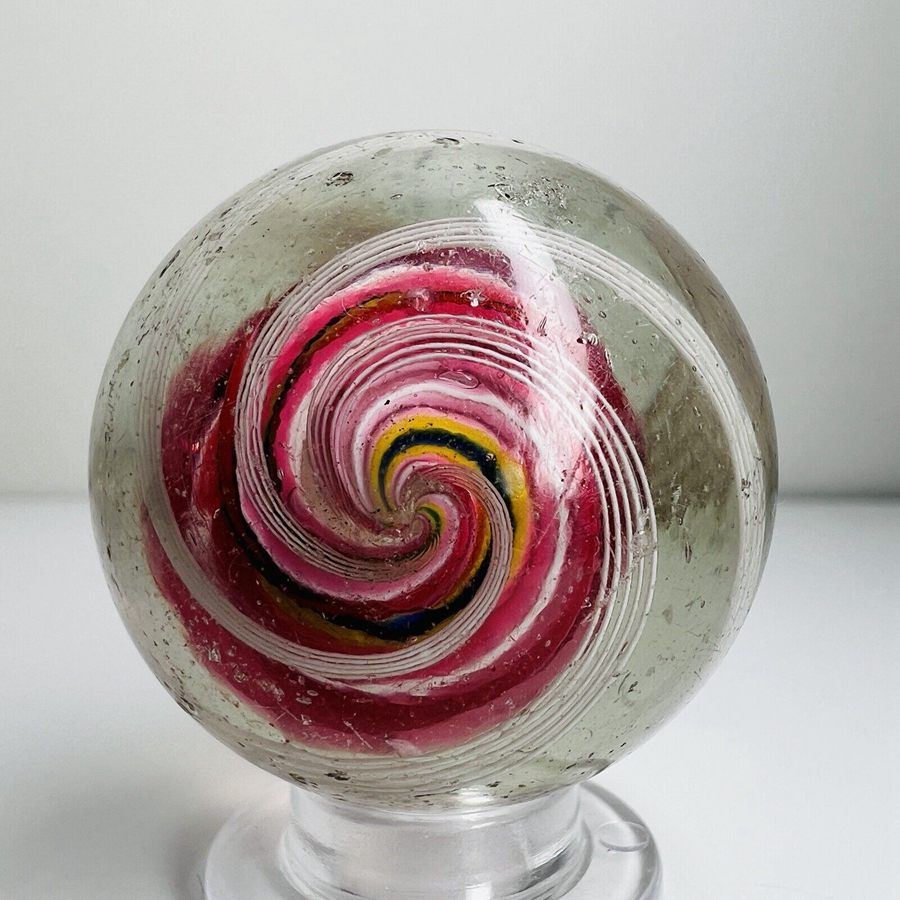
- Single pontil birdcage marble: this marble boasts a unique cage design.
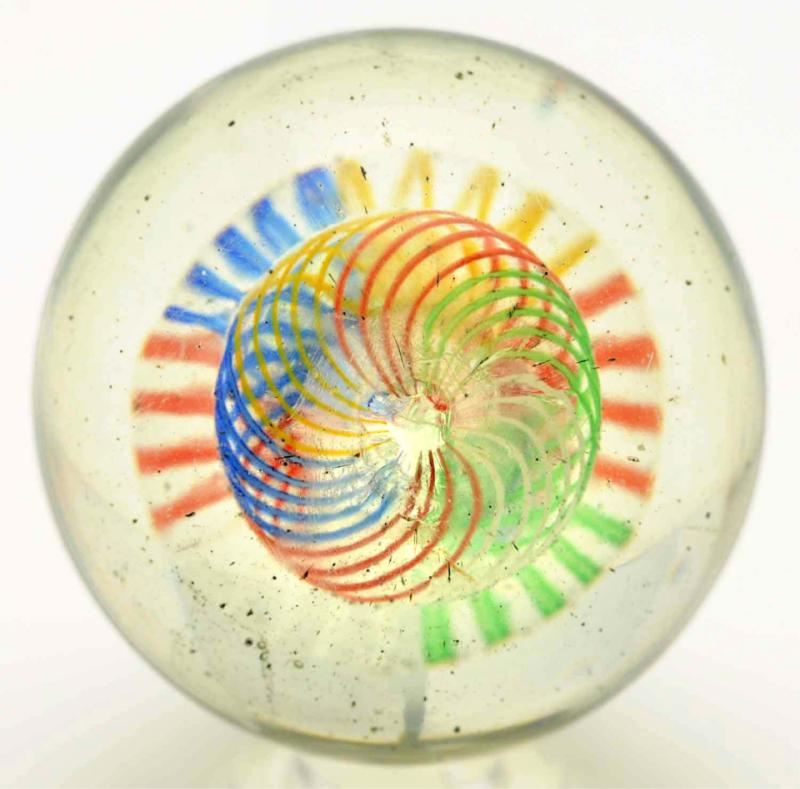 Single pontil birdcage marble (Image Creidt: Mmorphyauctions)
Single pontil birdcage marble (Image Creidt: Mmorphyauctions)
Another example of handmade marbles is the Indian mag-lite marble, known for its multicolored spiraling ribbons and opaque center. The size, color, and style of handmade marbles are varied, making them sought after by collectors.
Machine Made Marbles
While handmade marbles are quite valuable, machine-made marbles can also be rare and valuable. The Akro Agate Company, for instance, produced unique glass marbles with distinct banding and color combinations. One example is the precision banded Indian swirl marble. Some noteworthy types include:
- Clambroth: These marbles are opaque with evenly spaced colored bands.
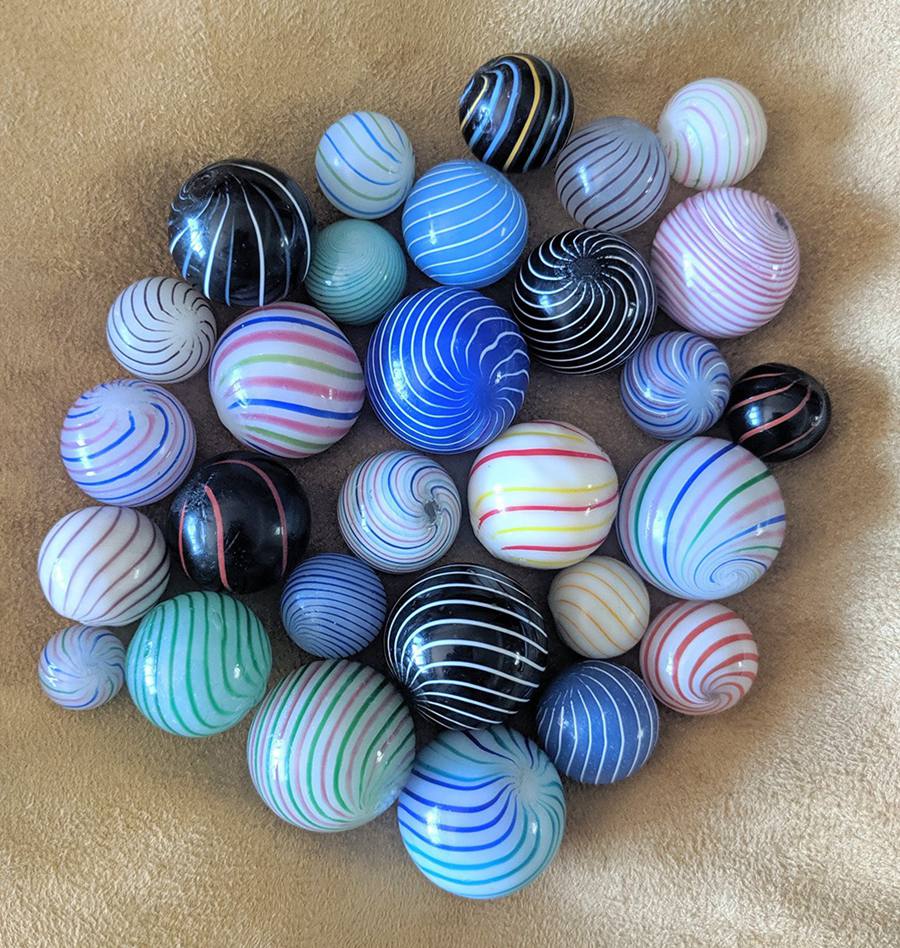
- Ghost: A type of marble with wispy, ghost-like swirls inside.
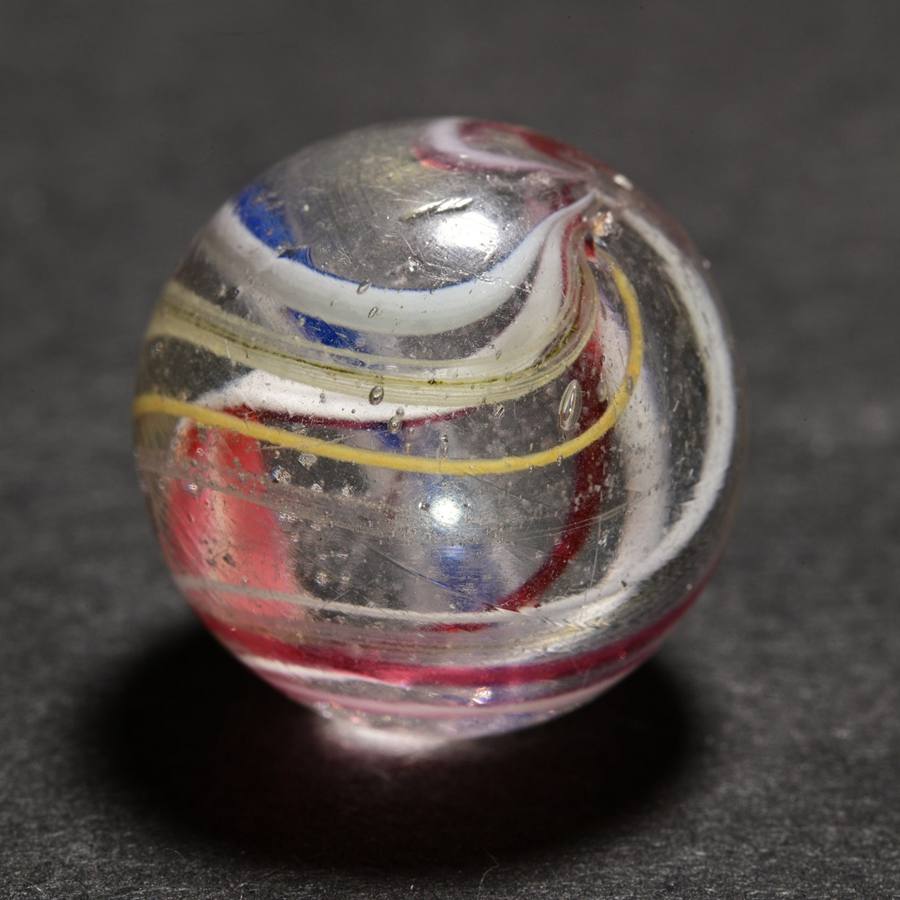
- Paneled onionskin German marble: Known for its vibrant and complex patterns, this machine-made marble is quite collectible.
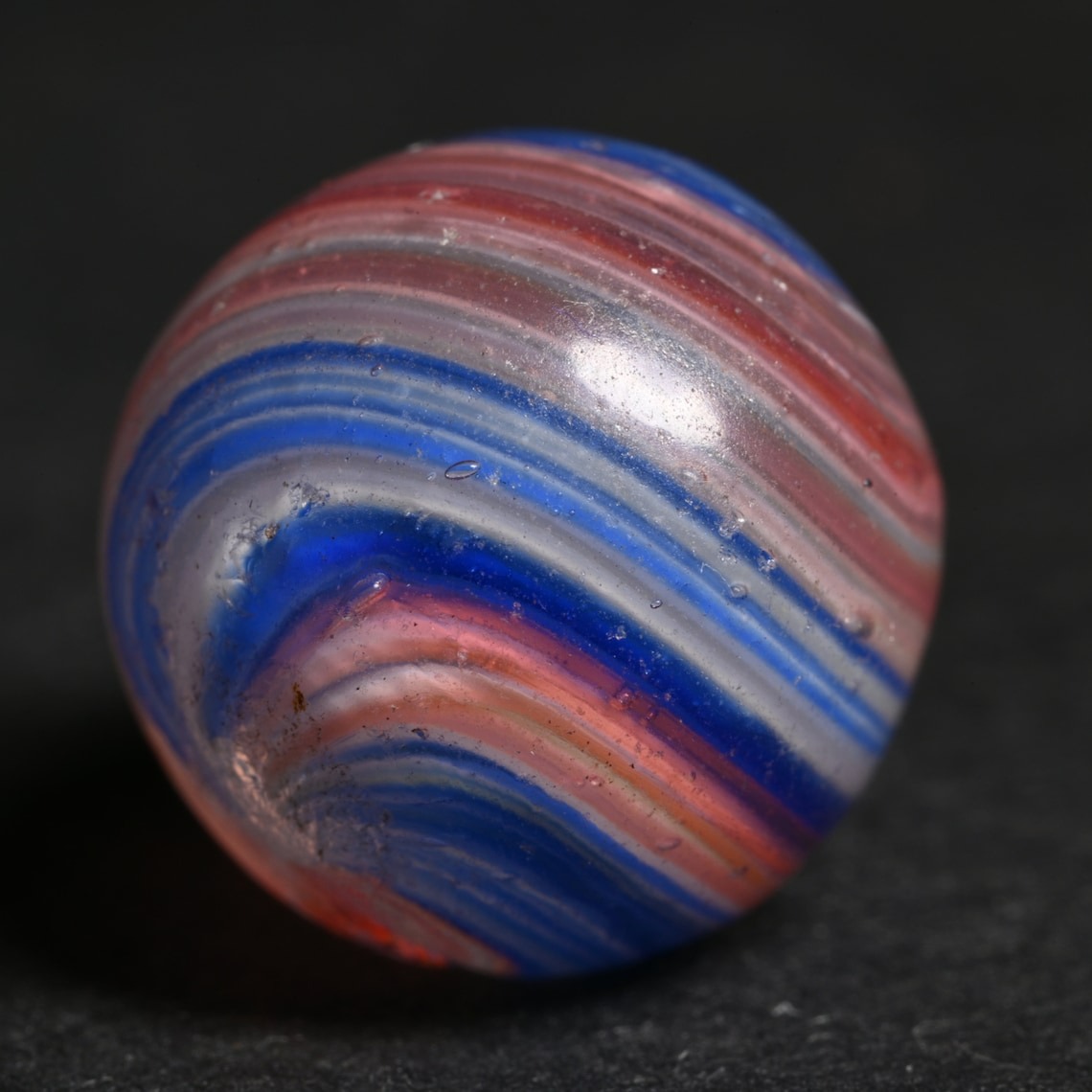
Sub-Types
There are also several sub-types of marbles, some of which are rare and valuable. Examples include:
- Sulphides: Transparent marbles with a flower, human, or animal figurine inside. Rare pieces, called doubles, contain two figures. Vintage marbles typically cost around $75, while rare doubles can reach $995 at auction.
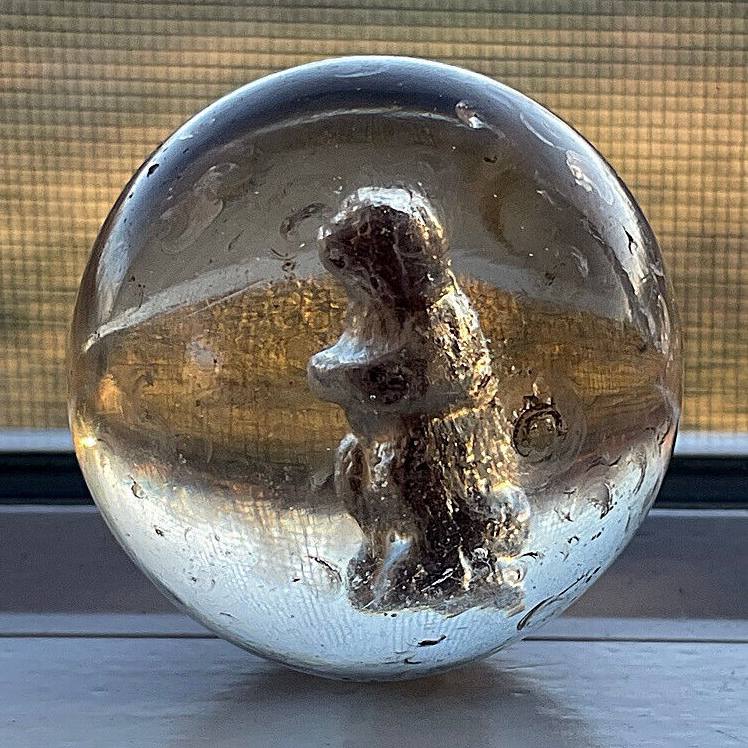
- Steelies: These marbles are made of steel and are often used in marble games.

- Black and white Navarre marble: Valued at approximately $1,400, this marble boasts a stunning contrast of black and white.
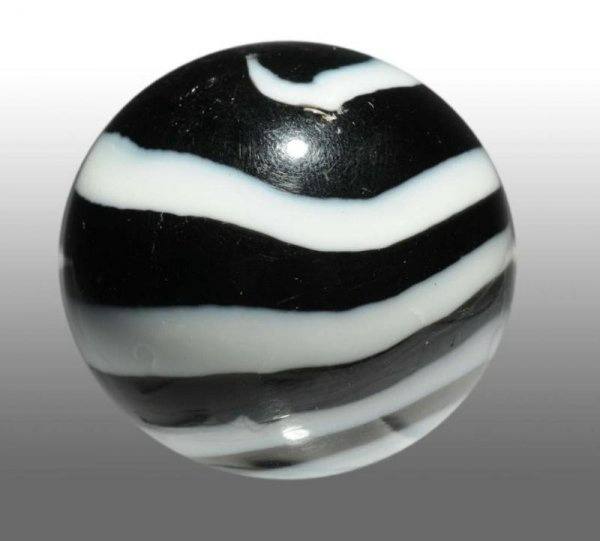
In addition, there are several other sub-types, such as divided ribbon core swirl marbles, single gather confetti marbles, and spotty onionskin shrunken marbles, each possessing unique characteristics that make them desirable to collectors.
As you explore the fascinating world of rare antique marbles, it’s essential to be aware of the diverse types available, their material compositions, and their visual characteristics. By understanding these aspects, you can better appreciate their artistry and intricacies while also determining their potential value as collectibles.
Famous Manufacturers and Their Marks
When exploring the world of antique marbles, it’s essential to familiarize yourself with famous manufacturers and their distinctive marks. In this section, you will learn about some of the most iconic marble manufacturers and how to identify their marbles based on signature design elements.
M.F. Christensen & Son
M.F. Christensen & Son was an early 20th-century American company that played a significant role in the machine-made marble industry. They are known for their innovative glass marble production techniques. Some of their marbles feature a characteristic nine design, which can be a helpful identifier. Notable marbles from this manufacturer include:
- Amber Slags: These marbles feature a semi-opaque base with swirls of amber.
- Guineas: Characterized by their distinct black and white patterns, these marbles can be highly sought after by collectors.
Christensen Agate
Another prominent American company, Christensen Agate, produced a wide variety of marbles in the early 20th century. Their marbles are known for their vibrant colors and intricate patterns. Identifying features of Christensen Agate marbles can include:
- Swirls: One of their most recognizable marks, the swirl patterns on these marbles can help identify them as Christensen Agate pieces.
- Electric and Royal Agates: Highly collectible, these marbles come in lively hues, with Electric Agates typically showcasing neon-like colors.
Akro Agate
Akro Agate is another American company renowned for its colorful marbles. Some of their most iconic marbles are:
- Corkscrews: Characterized by their twisting ribbon-like swirls, these marbles are a classic Akro Agate design.
- Popeyes: Made of transparent glass with colored spirals, Popeyes are easy to spot due to their unique appearance.
Peltier Glass
Peltier Glass, also an American manufacturer, produced machine-made marbles in the first half of the 20th century. They are known for their distinct designs and patterns, including:
- Cat’s Eyes: A classic Peltier design, these marbles contain colorful inserts resembling cat’s eyes.
- Slags: Featuring opaque glass with swirls of a contrasting color, Slags are another popular Peltier marble type.
By recognizing the marks and designs of these famous marble manufacturers, you can better identify and value antique marbles in your collection. Keep this guide as a handy reference the next time you encounter a unique and potentially valuable marble.
Notable Marbles and Their Value
Most Valuable Handmade Marbles
In the world of marble collecting, a few antique marbles consistently stand out for their rarity and value. Here are some of the most valuable handmade marbles to keep an eye out for in your collection:
- End-of-Day Marbles: These marbles are created from leftover glass at the end of the day, which can result in unique color combinations and patterns. The value of these marbles varies depending on factors such as size, color, and condition.
- Onionskin Marbles: Known for their delicate swirls of color, onionskin marbles can be among the most valuable. Examples include the Onionskin Peacock Lutz Marble and the Onionskin Blizzard Marble.
- Lutz Marbles: Characterized by their glittering metallic swirls, Lutz marbles are highly sought after. One example is the Pink Opaque Lutz Marble, which showcases vibrant colors and metallic luster.
- Paneled Onionskin German Marble: These marbles feature intricate panel designs and vibrant colors. An example is the Single Pontil Birdcage Marble, which has a value of around $7,670.
- Indian Mag-Lite Marble: Recognized by their opaque black base and mica flecks, these marbles have colorful bands and an average value of about $40.
Some of the most expensive marbles include the Black and White Navarre Marble ($1,400), the 4-Lobed Confetti Marble ($5,015), and the Double Figured Fish Sulfide Marble ($5,900).
Notable Auction Sales
Auction houses such as Morphy Auctions have facilitated the sale of several rare and valuable marbles. Some examples of noteworthy sales include:
- In March 2009, a 4-Panel Onionskin Marble with suspended mica bits sold for $2,632.50 (including a 17% buyer’s premium).
- A Single Gather Confetti Mica Marble, notable for its intense colors and rarity, was priced at $10,999.
- Divided Ribbon Core Swirl Marbles, featuring bands of color that create striking visual effects, can fetch high prices at auction, depending on their condition and size.
When assessing the value of your marble collection, consider factors such as the history and rarity of each piece, as well as its size, color, and condition. Pontil marks can also be an essential aspect of identification, as they provide insight into the manufacturing process.
As a collector, familiarizing yourself with the characteristics of valuable marbles, along with notable auction sales, will help you better understand the intricacies of this fascinating hobby.
Tips for Identifying Antique Marbles
When you’re trying to determine if a marble is an antique, keep the following tips in mind.
- Examine the Pontil: Most vintage marbles were made by hand through a process called glassblowing. During this procedure, a stick is used where the marble is attached. Once done, the stick is broken on its end. Look for a pontil mark, which is the scar where the marble was detached from the stick. If you see this mark, it’s a strong indicator that the marble is vintage.
- Consider the Size: Antique marbles typically have a diameter of 13-14 mm, with elongated centers and flat tops. If the marble you’re examining falls within this range, it may be an antique.
- Search for Figures: Some antique marbles, particularly those made in Germany, have animal figures or white bubbles at the center. If you find a marble with these features, it could signal that it’s antique.
- Check the Material: Marbles have been made from various materials throughout history, including wood, clay, and stone. Antique marbles made from non-glass materials are likely to be rare and valuable, so consider what the marble is made from as you attempt to identify its age.
- Familiarize Yourself with Lutz Marbles: These types of marbles, which can be highly prized by collectors, are unique due to their distinctive patterns. There are four main types of Lutz marbles: Banded Lutz, Onion Skin Lutz, Ribbon Lutz, and Mist Lutz. Remember that identifying a Lutz pattern on a marble could indicate its rarity and value.
By following these tips and keeping an eye out for specific features, you’ll increase your chances of accurately identifying antique marbles in your collection.
Collecting Antique Marbles
When starting your journey in collecting antique marbles, it’s essential to know what factors to consider and where to find these collectible items. By understanding these aspects, you’ll be better equipped to make informed decisions and build a valuable collection.
What to Consider When Collecting Antique Marbles
- Identification: Becoming familiar with various types of antique marbles is crucial to start your collection. Use resources like online reference guides to help you identify and differentiate between handmade and manufactured marbles, along with understanding their unique features.
- Condition: The condition of an antique marble directly impacts its value. Aim to collect marbles in near-mint to mint condition, as they will be more valuable and sought after.
- Rarity: Some marbles are rarer than others, making them more valuable for collectors. Research the different types of marbles and their rarity to ensure you’re acquiring marbles that will increase in value over time. For instance, some rare antique marbles include the King’s Rose marble and Yellow mica marble with a ghost core.
- Size: The size of the marble can also play a role in its value. Generally, larger marbles are more valuable than smaller ones. However, this is not always the case, so it’s essential to consider size as only one aspect of the marble’s overall appeal and worth.
Where to Find Collectible Antique Marbles
- Auctions: Participate in online and offline auctions that specialize in antique marbles. These events may be a goldmine for finding rare and valuable marbles unavailable elsewhere.
- Online marketplaces: Platforms like eBay, Etsy, and dedicated marble collecting websites like Old Rare Marbles offer a vast selection of antique marbles for sale. This ensures you have access to a diverse range and can compare prices to get the best value for your collection.
- Antique stores: Visit local antique shops or malls to find unique marbles not readily available online. Keep in mind, though, that not all antique stores may have knowledgeable staff to help identify and price marbles correctly, so it’s essential to know what you’re looking for before you shop.
- Estate sales: Occasionally, estate sales can be a treasure trove for antique marble collectors. Be sure to attend sales that have toy or marble collections, as these are more likely to offer valuable finds.
Remember, collecting antique marbles requires time, research, and patience. It’s essential to develop a keen eye for quality, rarity, and authenticity to build a collection that truly reflects your passion and investment in this unique hobby.
Selling Your Antique Marbles
Before selling your antique marbles, it’s crucial to accurately identify and determine the value of the marbles. To do this, consider factors such as the marble’s diameter, any distinctive features or figures, and the presence of a pontil mark. Once you have identified the marbles, you can start thinking about where to sell them.
There are several options for selling antique marbles, each with their advantages and disadvantages. Here are some popular options:
- Auction Houses: Auction houses, both local and online, are a popular choice for selling valuable antiques. They usually have a knowledgeable staff and can give your marbles more exposure to potential buyers. However, auction houses often charge fees or commissions.
- Antique Dealers: Some antique dealers specialize in marbles and may be interested in purchasing your collection. They can provide expert guidance and help you determine the accurate value for your marbles. Keep in mind that antique dealers need to make a profit, so they may not offer the highest price.
- Online Marketplaces: Websites like eBay and Etsy are popular options for selling antiques, including marbles. They offer a convenient way to reach a broad audience of potential buyers. However, competition can be fierce, and you may need to pay fees for listings and sales.
- Marble Collector Forums: Joining online forums for marble collectors can provide valuable insight, advice, and connections. By participating in these communities, you can learn more about the value of your marbles and possibly find buyers from within the group.
Resources for Researching Antique Marbles Values
If you prefer a physical book for your research, Collecting Antique Marbles: Identification and Price Guide is a reputable resource. This book offers historical facts, images of the rarest and most collectible marbles in the world, collecting tips, advice, and up-to-date pricing information. It covers more than 100 different subgroups of marbles and is a valuable tool for any avid marble collector.
Collecting and Caring for Antique Marbles
Tips for Beginners
As you begin your journey into the world of collecting antique marbles, start by familiarizing yourself with the different types and sub-types of marbles. The popularity and price points of vintage marbles may vary depending on the companies that produced them, their age, and rarity. A good reference guide or online resource can be invaluable to help identify desirable pieces.
When examining old marbles, look for telltale signs of their age and origin, such as:
- Deformation or a deep pontil on the edge, indicating handmade marbles from the mid-1800s to the early 1900s.
- Patchwork and striped patterns, often seen in antique marbles and valued around $40-$50.
Keep track of your collection and its value by maintaining a detailed inventory, including pictures, descriptions, and acquired prices.
Display and Storage
To properly showcase your antique marbles and protect them from damage, consider investing in a suitable display case or storage container. Options may include:
- Glass display cases with adjustable shelves
- Custom-made wooden cases with individual compartments
- Velvet-lined drawers or trays
Make sure your storage solution prevents marbles from rubbing together, which can lead to scratches and abrasions. Store displays and containers in an area with stable temperature and humidity levels, to avoid any adverse effects on the marbles.
Cleaning and Maintenance
Cleaning and maintaining your vintage marbles is crucial to preserving their value and appearance. Follow these guidelines:
- Use a soft, lint-free cloth and mild soap when necessary to gently clean your marbles.
- Avoid abrasive cleaning agents or methods that could damage the surface.
- Dry your marbles completely with a clean, soft cloth to prevent water stains or spots.
Remember to handle your antique marbles with care and always wash your hands before touching them, as oils and dirt from your fingers can damage their surfaces. By diligently following these tips and recommendations, you’ll ensure that your collection of rare, old marbles remains in prime condition for years to come.
Marble Games and Uses
Marble games have been a popular pastime for centuries, dating back to ancient times. As a marble collector, understanding the various games and uses for these intricate and unique collectibles can enhance your appreciation for them.
One of the most well-known marble games is “Marbles.” To play this classic game, you’ll need a smooth surface, a circular playing area, and a set of marbles. Players take turns flicking their marbles into the center, trying to knock out other marbles or occupying the middle space. The winner is the player with the most marbles captured or pushed out of the playing area.
Another popular game involving marbles is “Ringer.” In this game, a larger circle is drawn, and smaller marbles are placed within it at equal intervals. The goal is to knock these marbles out of the ring using your “shooter” marble (usually a larger, heavier marble). Successful shots earn you points, and the player with the most points at the end of the game wins.
Aside from these traditional games, there are numerous other ways marbles can be used:
- Marble mazes: Create your own marble maze using LEGO bricks, cardboard tubes, or even repurposed household items. This is a fun and creative way to enjoy your marbles.
- Marble art: Arrange your marbles into beautiful patterns and designs, then take photos or even frame them for display.
- Decoration: Use marbles to fill a clear vase or jar for an eye-catching conversation piece.
- Marble-run contraptions: Similar to a maze, create a complex course for your marbles to travel through using various materials and objects.
As you explore marble games and uses, remember that many antique marbles were made through the process of glassblowing. This technique involves molten glass being shaped and spun over a stick, which is then broken off at the end, leaving a telltale mark called a “pontil.” This small detail can help you identify vintage marbles and appreciate the skill and artistry that went into their creation.
With so many marble games and uses, the possibilities for enjoyment and collecting are vast. Embrace the history and craftsmanship behind these tiny treasures, and you’ll soon find yourself immersed in a rewarding hobby.
Final Thoughts
Now that you’re familiar with the different types of rare antique marbles and their value, it’s essential to consider the factors in marble identification. Pay close attention to the marble’s age, style, and condition, as these aspects greatly impact their value.
When examining your marbles, look for unique features such as:
- Swirl patterns
- Core designs
- Pontil marks
- Surface condition
Remember to research and compare your marbles with reputable sources or consult experts in the field. The more informed you are, the better you can assess the rarity and value of your collection.
In addition, it’s crucial to be aware of imitations in the market. Use your newfound knowledge to avoid being misled by forgeries masquerading as genuine antiques. Grow and develop your skills through continuous learning and experience in the world of rare antique marbles.
By following these guidelines, you can successfully appraise and cultivate your collection, staying ahead of the curve in this fascinating and rewarding hobby.

